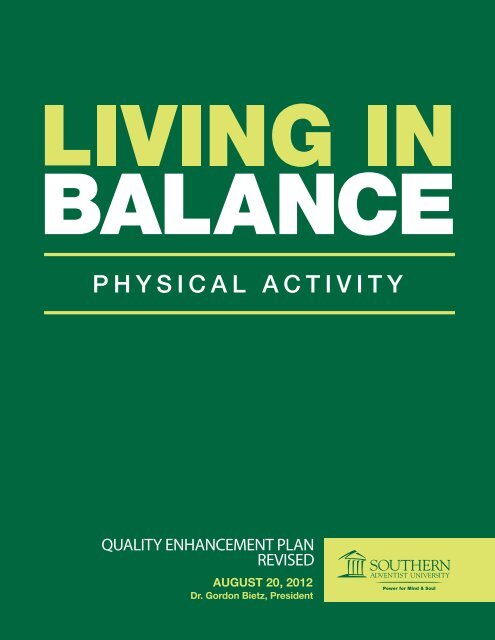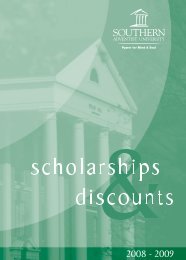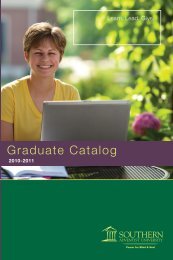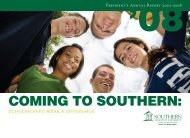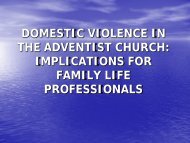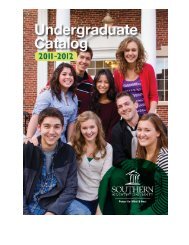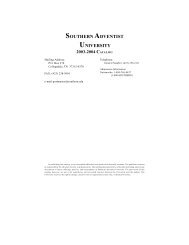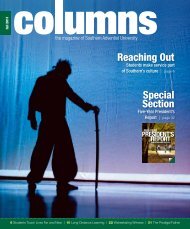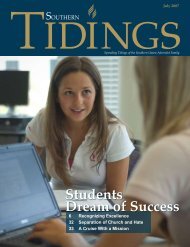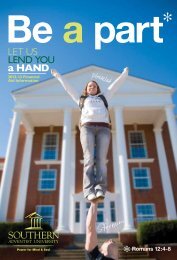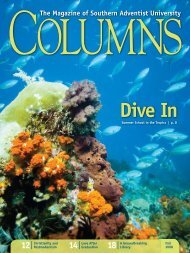Physical Activity QEP - Southern Adventist University
Physical Activity QEP - Southern Adventist University
Physical Activity QEP - Southern Adventist University
Create successful ePaper yourself
Turn your PDF publications into a flip-book with our unique Google optimized e-Paper software.
SOUTHERN ADVENTIST UNIVERSITYExecutive SummaryThe mission of <strong>Southern</strong> <strong>Adventist</strong> <strong>University</strong> includes nurturing Christ-likeness andencouraging the pursuit of truth, wholeness, and a life of service. To strengthenthe pursuit of wholeness, the theme of physical activity was chosen for our qualityenhancement plan (<strong>QEP</strong>) and is supported by university faculty, students, and otherstakeholders.The focus of the “Living in Balance: <strong>Physical</strong> <strong>Activity</strong>” <strong>QEP</strong> is to enhance student1. at <strong>Southern</strong> <strong>Adventist</strong> <strong>University</strong>.2. Students will achieve and maintain the American College of Sports Medicinerecommendations for cardiorespiratory physical activity.These outcomes will be achieved through substantial changes in coursesand general education requirements and through co-curricular opportunities thatfunding to support implementation.Changes in the curriculum include: (1) increasing the two-hour general educationphysical activity requirement to four hours, (2) requiring one physical activity course perNew co-curricular opportunities include: (1) organizing and promoting a mid-semesteractivity website.The assessment strategy employs two standardized instruments: the Rockport One-<strong>Activity</strong> Questionnaire (IPAQ) for assessing cardiorespiratory activity.Funding is allocated for the cost of equipment, supplies, and human resources,including a part-time <strong>QEP</strong> director to guide implementation and evaluation of theplan and an additional full-time faculty member to teach courses related to the newrequirements.1
SOUTHERN ADVENTIST UNIVERSITYBased on the stakeholder data and <strong>University</strong> Senate input, the <strong>QEP</strong> selection taskforcelearning. The taskforce presented the three choices to the <strong>University</strong> Assembly (facultyand salaried staff) on February 22, 2010, and obtained written and oral feedback. Astraw poll overwhelmingly eliminated service learning from the options.Then with input from the <strong>University</strong> Senate on March 15, 2010, the <strong>QEP</strong> taskforceto a specially called faculty meeting for a decision on April 5, 2010. The <strong>QEP</strong> taskforcepresented opening statements after which the faculty discussed each topic in an openforum and voted by paper ballot to recommend “Living in Balance: <strong>Physical</strong> Fitness.” TheLater in April 2010, President Bietz appointed the <strong>QEP</strong> working committee (listedworking committee met weekly during fall 2010, winter 2011, and fall 2011 semesters todiscuss and develop a manageable and sustainable plan.In the fall of 2010, while initially developing student-learning outcomes, the workingpositive term and would be more inviting for all students regardless of their current levelconsidered whether a volunteer or required program would be most effective. Theconclusion was that the program would have a greater impact on student learning as anacademic requirement.Table 4. <strong>QEP</strong> Working CommitteeMEMBER TITLE DEPARTMENTJudy Sloan, chair Professor School of PE, Health, and WellnessPatti Anderson Professor MathematicsMichael Dant Associate professor School of ComputingLeslie Evenson Director Wellness InstituteTyson Hall Professor School of ComputingHollis James Director Institutional Research and PlanningHarold Mayer Professor School of PE, Health, and WellnessMarge SeifertPublic services librarian,associate professorMcKee Library6
SOUTHERN ADVENTIST UNIVERSITYLiterature Review and Best PracticesEducational institutions of the Seventh-day <strong>Adventist</strong> (SDA) church have a rich heritageof providing a broad-based holistic education that values the physical, mental, andspiritual growth of students, as is evidenced by this statement in 1903 from Ellen G.White, one of the church founders:Our ideas of education take too narrow and too low a range. There is need of a broaderscope, a higher aim. True education means more than the perusal of a certain courseof study. It means more than a preparation for the life that now is. It has to do with thewhole being, and with the whole period of existence possible to man. It is the harmoniousdevelopment of the physical, the mental, and the spiritual powers. It prepares the studentfor the joy of service in this world and for the higher joy of wider service in the world tocome. (Education, p. 13)Consequently, true education is understood and embraced at <strong>Southern</strong> <strong>Adventist</strong><strong>University</strong> as being more than earning a degree;; it includes development of the wholebeing. Educating students in physical activity training directly supports our mission toencourage the pursuit of wholeness.Literature ReviewThe literature review is organized into four parts: physical activity levels among collegestudents, the correlation between physical activity and health risks, physical activitystatistics for Tennessee, and physical activity data results for <strong>Southern</strong> <strong>Adventist</strong><strong>University</strong> students.<strong>Physical</strong> <strong>Activity</strong> Levels Among College StudentsResearch shows that physical activity levels decline as students progress througheducational levels. Bray and Born (2004) identify a decline in vigorous physical activityvigor compared with those who continued to be active.” (p. 181)Similarly, a 1999 report from the surgeon general shows a general decline in activitylevel for adolescents from the ages of 14 to 20:7
SOUTHERN ADVENTIST UNIVERSITYmore physical activity than those who attend PE less often. A nationally representative studyof U.S. high school students found that a binding PE requirement increased levels of bothregular physical activity and vigorous exercise. <strong>Physical</strong> education programs that include the use of standardized curricula, goals for activeclasses and staff development result in children who are more physically active…. Quality in-service training for teachers, either for PE specialists or for classroom teachers,increases students’ levels of physical activity at school. However, PE specialists producegreater physical activity levels in children…. Whole school programs that provide additional opportunities for physical activity across theschool day—through recess, in-class breaks and after-school events—increase children’sphysical activity levels…. School environments with well-designed playgrounds, open spaces, facilities and equipmentthat are available, accessible, and inviting to children encourage more physical activity,both during and after school. Based on a study of more than 16,000 children, studentswere nearly three times as likely to be active when there were greater numbers of outdoorfacilities at their school. (p. 3-4)These studies suggest that while student’s activity levels are shown to decline asthey move through the educational system, incorporating physical activity requirementsinto the curriculum increases activity levels.<strong>Physical</strong> <strong>Activity</strong> and Health RisksWhen academic institutions do not require students to be physically active or create apositive environment for participating in physical activity, students are less active and areat greater risk for lifestyle diseases. In the April 2011 issue of the American Journal ofPublic Health, Conn, Hafdahl, and Mehr, state that “adequate physical activity is linkedwith important health outcomes, including reductions in cardiovascular disease, type 2diabetes, some cancers, falls, osteoporotic fractures, and depression, and improvementsin physical function, weight management, cognitive function, and quality of life” (p. 751).The physical activity and health fact sheet published in 2011 by the Centers for Disease More than 60 % of U.S. adults do not engage in the recommended amount of activity. Approximately 25% of U.S. adults are not active at all.In addition to the low level of physical activity, the fact sheet states that: The proportion of U.S. adults who are obese was 33.9% in 2007-2008. The medical costs of obesity were as high as $147 billion in 2008. The average annualmedical costs for an obese person are $1,429 more than those of a normal weight person. In 2010, 11.3% of the population aged 20 years or older, or 25.6 million people, haddiabetes. The medical costs of diabetes were $116 billion in 2007. The average medical expenditures9
SOUTHERN ADVENTIST UNIVERSITYamong people with diagnosed diabetes were 2.3 times higher than what expenditures wouldbe in the absence of diabetes.According to Boyle and LaRose (2008) “physical inactivity and poor diet causeobesity and are the leading causes of death in America” (p. 195).<strong>Physical</strong> <strong>Activity</strong> Statistics for TennesseeStatistics from the 2010 physical activity report by the CDC for the State of Tennessee,home to <strong>Southern</strong> <strong>Adventist</strong> <strong>University</strong>, indicate that 27 percent of the adult populationin Tennessee gets no leisure-time physical activity. The report also shows Tennesseeas ranked lowest in the United States for being physically active (51.8%) and highlyphysically active (29.9%).<strong>Physical</strong> <strong>Activity</strong> Data Results for <strong>Southern</strong> <strong>Adventist</strong> <strong>University</strong> StudentsAt <strong>Southern</strong> <strong>Adventist</strong> <strong>University</strong>, 77 percent of the student population is between theages of 18 and 24 —the student group shown to be more likely to have lower activitylevels resulting in greater health risks. Considering this fact, the School of <strong>Physical</strong>areas under investigation are:1. 2. Students’ physical activity levels as compared with national normsthat only 26.7 percent of the student population achieves a level-3 or higher rank onthe pre-test and only 37.2 percent achieves a level-3 or higher rank on the post-test asChart 1. Cardiorespiratory Fitness Results1007550Level 1–2Level 3–5CardiorespiratoryFitness RankLevel 1Level 2Level 3Level 4Level 5LowBelow averageAverageAbove averageHigh250Pre-testPost-test10
SOUTHERN ADVENTIST UNIVERSITYtest, but these results do not meet the goal of having 50 percent of students achieve aWhen comparing Fitness for Life students’ physical activity levels with nationalnorms, we found <strong>Southern</strong> <strong>Adventist</strong> <strong>University</strong> students to be less active (16%) than thenational college norm (19%) as shown in Chart 2.Chart 2. Exercise Frequency ComparisonHEALTH ASSESSMENT COLLEGE NORM SAU STUDENTSExercise Frequency 5+ times/week 1,2 19% 16%1American College Health Association. National College Health Assessment. Spring 2010 ReferenceGroup Executive Summary, p. 162BSDI – Fitness Analyst results from 3,445 <strong>Southern</strong> <strong>Adventist</strong> <strong>University</strong> students (2007 - 2011) Students transitioning from high school to college become less physicallyactive. Colleges and universities require fewer physical education activity courses thanin past decades. Whole-school [elementary and secondary] programs that require physicalgoals, provide access to recreation programs, and create an environment forencouraging physical activity both during and after school show a positiveincrease in student physical activity levels. Inactivity leads to greater health risks and higher healthcare costs. Tennessee adults are less physically active than adults in other states. <strong>Southern</strong> <strong>Adventist</strong> <strong>University</strong> students on average are not as physicallyactive as students at other colleges and universities, with less than 38 percentAccording to Dr. Thom L. McKenzie, emeritus professor of exercise and nutrition atSan Diego State <strong>University</strong>, the three ways to increase physical activity are by individualintervention, by creating a positive environment for physical activity, and through policychange. Of these three, policy change is the most effective at producing sustainabletransformation. (Lecture, February 10, 2011)The “Living in Balance: <strong>Physical</strong> <strong>Activity</strong>” plan is designed to increase the physicalactivity of <strong>Southern</strong> <strong>Adventist</strong> <strong>University</strong> students through three key policy changes:11
SOUTHERN ADVENTIST UNIVERSITY1. Increasing the two-hour general education physical activity requirement to fourhours.2. Requiring one activity course per year for baccalaureate-degree students.3. Best PracticesBest practices were investigated in two main areas: (1) the physical activity standardsset by professional organizations for maintaining a healthy lifestyle and (2) the physicalactivity requirements for institutions similar to <strong>Southern</strong> <strong>Adventist</strong> <strong>University</strong> in size and/<strong>Physical</strong> <strong>Activity</strong> Standards Established by Professional OrganizationsIn a Journal of the American Medical Association (1995) article, “<strong>Physical</strong> <strong>Activity</strong>and Public Health,” collaborative efforts from the CDC and the American College ofSports Medicine (ACSM) are reported. The conclusion is that “every U.S. adult shouldaccumulate 30 minutes or more of moderate-intensity physical activity on most,preferably all, days of the week” (p. 404).The CDC, ACSM, and the American Heart Association (AHA) are viewed as credibleorganizations and all three have published similar standards for physical activity. All threerecommend that adults get 150 minutes a week of moderate-intensity aerobic physicalthat adults may choose to get 60 minutes of vigorous-intensity aerobic activity insteadof moderate-intensity. The AHA and the CDC recommend that adults may choose toget 75 minutes of vigorous-intensity aerobic activity instead of moderate-intensity.A combination of the intensity and time equivalents is also an option. The CDC alsominutes (5 hours) a week of moderate-intensity aerobic activity, or 150 minutes a weekof vigorous-intensity aerobic activity or a combination equivalent.<strong>Southern</strong> <strong>Adventist</strong> <strong>University</strong> students are not meeting the recommended weeklystandard for physical activity. Only 16 percent of the PEAC 225–Fitness for Life classmeets the weekly recommendation compared to the national college norm of 19 percent.(See Chart 2: Exercise Frequency Comparison, in the Literature Review section.)<strong>Physical</strong> <strong>Activity</strong> Requirements at Similar InstitutionsA comparison of <strong>Southern</strong> <strong>Adventist</strong> <strong>University</strong> general education requirements withthose at similar institutions reveals that our requirement of two hours of physical activityfor baccalaureate-degree students lags behind three other Seventh-day <strong>Adventist</strong> institutionsand two regional institutions of similar size.12
SOUTHERN ADVENTIST UNIVERSITYThe <strong>QEP</strong> working committee concludes that our general education requirementsfor physical activity are not consistent with best practices according to the standardssuggested by the CDC, AHA, and ACSM and the standards of similar institutions ofhigher education. This disparity calls for action considering the emphasis in our missionto encourage the pursuit of wholeness.committee has developed student learning outcomes and an action plan that will correctTable 5. Comparison of <strong>Physical</strong> <strong>Activity</strong> RequirementsINSTITUTIONACTIVITY HOURSAndrews <strong>University</strong> 4Union College 4Bryan College 4Southwestern <strong>Adventist</strong> <strong>University</strong> 3Covenant College 3<strong>Southern</strong> <strong>Adventist</strong> <strong>University</strong> 2Washington <strong>Adventist</strong> <strong>University</strong> 1Lee <strong>University</strong> 113
SOUTHERN ADVENTIST UNIVERSITYDesired Student Learning Outcomesa view of education as affecting more than just the mind. The mission encourages thepursuit of wholeness, the vision aims to graduate servant leaders committed to livingbalanced lives, and one of the core values is a balanced lifestyle.spiritual development, intellectual development, individual and social development,physical development, and discipline-‘‘in Balance: <strong>Physical</strong> <strong>Activity</strong>” <strong>QEP</strong>,There is no exercise that can take theplace of walking. By it the circulation<strong>Southern</strong> <strong>Adventist</strong> <strong>University</strong> seeksof the blood is greatly improved.to strengthen student learning in thegeneral education area of physicaldevelopment.The student learning outcomes<strong>Adventist</strong> <strong>University</strong> students, and a recommitment to promoting healthy lifestyleprinciples foundational to Seventh-day <strong>Adventist</strong> education. Chart 3 is an overview of the1. Swhile at <strong>Southern</strong> <strong>Adventist</strong> <strong>University</strong>.The Rockport One-Mile Walking Test (see Appendix A) was selected as theinstrument (D’Alonzo, Marbach, and Vincent, 2006), because it is considered “anp. 75), and because of its ease to administer independently. Students will receiveinstructions for the assessment in activity courses and during the mid-semester campus-‘‘Moderate exercise every day will impartstrength to the muscles, which withoutTestimonies to the Church, vol. 2, p. 533Testimonies to the Church, vol. 3, p. 78throughout the lifespan. Improvingcalls for a consistent physical activityprogram. Students are encouragedto meet the minimum ACSM physicalactivity level each week as part of14
SOUTHERN ADVENTIST UNIVERSITYChart 3. Student Learning Goal and Outcomes<strong>QEP</strong> Focus Goal OutcomesThe focus of the“Living in Balance:<strong>Physical</strong> <strong>Activity</strong>”<strong>QEP</strong> is to enhancestudent learning incardiorespiratoryfitness.Goal 1Increase physicalfitness.Outcome 1.1Students will achieveand maintain a level-3cardiorespiratory fitnessrank while at <strong>Southern</strong><strong>Adventist</strong> <strong>University</strong>.Outcome 1.2Students will achieveand maintain theAmerican College ofSports Medicinerecommendations forcardiorespiratoryactivity.beginning or maintaining an active lifestyle. Also, the two required activity courses PEACcourse) will have the recommended ACSM physical activity levels as part of the courserequirements.2. Students will achieve and maintain the American College of Sports Medicinerecommendations for cardiorespiratory activity.Helping students develop a physically active lifestyle is the purpose of the secondstudent learning outcome.contraction of skeletal muscles that results in a substantial increase over resting energyexpenditure” (Thompson, Gordon, and Pescatello, 2010, p. 2).The ACSM physical activity parameter we expect <strong>Southern</strong> <strong>Adventist</strong> <strong>University</strong>students to know and adopt is that “all healthy adults aged 18-65 need moderate15
SOUTHERN ADVENTIST UNIVERSITYvigorous activity for a minimum of 20 minutes three days per week” (Thompson et al.2010, p. 8).The ACSM cardiorespiratory physical activity levels will be assessed using theInternational <strong>Physical</strong> <strong>Activity</strong> Questionnaire (IPAQ). The IPAQ will be completed bystudents when enrolled in physical activity courses on the physical activity websitedesigned by <strong>Southern</strong> <strong>Adventist</strong> <strong>University</strong>’s School of Computing.16
SOUTHERN ADVENTIST UNIVERSITYActions to be Implemented<strong>Southern</strong> <strong>Adventist</strong> <strong>University</strong> is dedicated to nurturing Christ-likeness and encouragingthe pursuit of truth, wholeness, and a life of service. The “Living in Balance: <strong>Physical</strong><strong>Activity</strong>” <strong>QEP</strong> is centered on student learning outcomes that enhance wholeness throughphysical activity. As the action plan in Chart 4 shows, the outcomes will be achievedthrough substantial changes in general education course requirements and through cocurricularopportunities that promote physical activity. Additionally, we are implementingstrategies for the assessment, evaluation, and improvement of physical activity, and areallocating funding to support implementation.Chart 4. Actions to be ImplementedPromote best practicesfor holistic education incardiorespiratoryfitness Add one FTE in PEHW Develop physical activitywebsite Redesign and development ofcourses Allow free activity course whenit is the student’s 17th hourOrganizationalSupportIncrease the physicalactivity level of students Increase the general educationphysical activity requirement Require one physical activity courseper year Incorporate two specific assessmentsinto all physical activity classes<strong>QEP</strong>AnalysisandEvaluationActions to beImplementedOutputsCurricularCo-CurricularDetermine overallsuccess of the “LivingIn Balance: <strong>Physical</strong><strong>Activity</strong>” <strong>QEP</strong> Determine the impact ofgeneral education curricularchanges Evaluate the impact ofactivity course curricularchangesAssessmentStrategyIntegrate uniform methodsof assessing studentcardiorespiratory fitness The Rockport One-Mile Walking Test The International <strong>Physical</strong> <strong>Activity</strong>QuestionnaireEnhance studentlearning experienceoutside of the classroom Organize and promote amid-semester campus-widefitness assessment week Create a physical activitywebsite17
SOUTHERN ADVENTIST UNIVERSITYCurricular OutputsThe focus of the actions to be implemented is to achieve the student learning outcomes.1. Increase the two-hour general education physical activity requirement to fourhours2. Require one physical activity course per year. (Outlines for each course in thefour-year sequence are listed in Table 6.) First year: PEAC 125–Fitness for Collegiate Life Second year: <strong>Physical</strong> activity course of the student’s choice Third year: <strong>Physical</strong> activity course of the student’s choice Fourth year: PEAC 425–Fit for Hire3. Complete the Rockport One-Mile Walking Test (SLO 1) Complete the International <strong>Physical</strong> <strong>Activity</strong> Questionnaire (SLO 2)The following general education physical development requirements will serve as afoundation for accomplishing the curricular outputs: Increase the physical development area requirement from 4-5 to 6-7 hours (toaccommodate the two-hour increase in required physical activity courses). Require baccalaureate-degree students to take four activity courses (includingPEAC 125–Fitness for Collegiate Life and PEAC 425–Fit for Hire) and a twohourhealth science course (HLED 173–Health for Life or HLNT 130–Nutritionfor Life), for a total of 6 hours.Baccalaureate nursing majors will take three activity courses (including PEAC125–Fitness for Collegiate Life and PEAC 425–Fit for Hire) and NRNT 125–Nutrition, for a total of 6 hours.Health science and corporate and community wellness majors will take fouractivity courses (including PEAC 125–Fitness for Collegiate Life and PEAC425–Fit for Hire) and HLNT 135–Nutrition for Life Enhanced, for a total of 7hours.See Table 7 for an overview of the changes in physical activity requirements forbaccalaureate-degree students in the general education area of physical development.Associate Degree and Transfer Student ExpectationsStudents seeking an associate degree will be required to take PEAC 125–Fitness forwhich has a physical activity component embedded within the course.18
SOUTHERN ADVENTIST UNIVERSITYTable 6. Four-Year <strong>Physical</strong> <strong>Activity</strong> Course SequenceFIRST YEAR SECOND YEAR THIRD YEAR FOURTH YEARPEAC 125–Fitness for CollegiateLifeComplete Rockport One-MileWalking Test at the beginning of thesemester to establish a baselineComplete Rockport One-MileWalking Test during mid-semesterweek. (SLO 1) (See Appendix A)Complete International <strong>Physical</strong><strong>Activity</strong> Questionnaire (SLO 2) (SeeAppendix B)Complete one activity course (orNRNT 125, which is required fornursing majors)Complete the Rockport One-MileWalking Test during mid-semesterweek. (SLO 1)Complete International <strong>Physical</strong><strong>Activity</strong> Questionnaire (SLO 2) (SeeAppendix B)Complete one activity course (orNRNT 125, which is required fornursing majors)Complete the Rockport One-MileWalking Test during mid-semesterweek. (SLO 1)Complete International <strong>Physical</strong><strong>Activity</strong> Questionnaire (SLO 2) (SeeAppendix B)PEAC 425–Fit for HireComplete Rockport One-MileWalking Test during mid-semesterweek. (SLO 1) (See Appendix A)Complete International <strong>Physical</strong><strong>Activity</strong> Questionnaire (SLO 2) (SeeAppendix B)Cohort: Baccalaureate-degree students19
SOUTHERN ADVENTIST UNIVERSITYTable 7. Changes to General Education <strong>Physical</strong> Development RequirementsCURRENT REQUIREMENTS<strong>Physical</strong> Development, 4-5 hoursP-1 <strong>Physical</strong> <strong>Activity</strong>, 2 hoursa. PEAC 225–Fitness for Life, 1 hourb. Choose one of the following:PEAC, ADAC, OLAC (all are 1 hour or more)NEW REQUIREMENTS<strong>Physical</strong> Development, 6-7 hoursP-1 <strong>Physical</strong> <strong>Activity</strong>, 4 hoursa. PEAC 125–Fitness for Collegiate Life, 1 hourb. Select two PEAC, ADAC, OLAC courses—onein the second year and one in the third year.Baccalaureate nursing majors select one andtake NRNT 125.c. PEAC 425–Fit for Hire, 1 hourP-2 Health Science, 2-3 hoursHLED 173–Health for Life, 2 hoursHLNT 135–Nutrition for Life, 3 hoursNRNT 125–Nutrition, 3 hours (required for nursingand allied health majors)P-2 Health Science, 2-3 hoursHLED 173–Health for Life, 2 hoursHLNT 130–Nutrition for Life, 2 hoursHLNT 135–Nutrition for Life Enhanced, 3 hours(required for PEHW majors)NRNT 125–Nutrition, 3 hours (required forbaccalaureate nursing majors)Transfer students must take PEAC 125–Fitness for Collegiate Life and PEACrequirements. Nutrition courses do not transfer to meet the activity requirement. Students who transfer in as sophomores (second year) must take oneadditional activity course. Students who transfer in as juniors (third year) or seniors (fourth year) are notrequired to take additional activity courses. Students who transfer in as seniors must take PEAC 125–Fitness for CollegiateRedesigned CourseIn order to achieve the student learning outcomes, the currently required course PEAC225–Fitness for Life will be redesigned to become PEAC 125–Fitness for Collegiate20
SOUTHERN ADVENTIST UNIVERSITYNew Senior Capstone CourseA senior capstone physical activity course, PEAC 425–Fit for Hire, will be added to theactivity as part of the course requirements (see Appendix D). PEAC 425–Fit for Hire willAssessment Requirements for All <strong>Physical</strong> <strong>Activity</strong> Courses<strong>Physical</strong> activity courses will require two standardized assessments:1. Students will be required to complete the Rockport One-Mile Walking Test (seeAppendix A) mid-way through the semester. The Rockport walk assessmentwill be required for students currently enrolled in an activity course and will bepromoted for all students on campus.2. Students will be required to complete the IPAQ (see Appendix B) mid-waythrough the semester.Co-Curricular Outputs1. 2. Create a physical activity website on which students will record Rockport Testresults, answer the IPAQ questions, log physical activity, create and evaluatefor data collection and analysis.By incorporating curricular and co-curricular outputs, we are creating a morepositive environment for sustained physical activity. The success of our curricular andco-curricular outputs will be determined by the extent to which we achieve our studentlearning outcomes.Assessment StrategyThe general education physical activity courses will incorporate uniform assessment of<strong>QEP</strong> includes two standardized instruments:1. The Rockport One-Mile Walking Test2. The International <strong>Physical</strong> <strong>Activity</strong> Questionnaire21
SOUTHERN ADVENTIST UNIVERSITYThe use of uniform assessment instruments for curricular requirements and cocurricularopportunities will tie together the various aspects of our student learning goaland contribute to the accomplishment of our student learning outcomes.<strong>QEP</strong> Analysis and EvaluationTo identify the overall success of the “Living in Balance: <strong>Physical</strong> <strong>Activity</strong>” <strong>QEP</strong> we willassess the following items:1. The impact of general education curricular changes on increasing studentphysical activity course completions over baseline data collected from graduatingclasses from winter 2009 through fall 2010 (Baseline for baccalaureatestudents: 22% taking 3 courses;; 15.5% taking 4 or more courses)2. The impact of activity course curricular changes on increasing: PEAC 225-Fitness for Life courses (Baseline: 26.7% scored level-3 on pretest;;37.2% scored level-3 on post-test) Student physical activity levels based on data from 2004–2011 PEAC 225–Fitness for Life courses (Baseline: 16% self-report meeting ACSM standards)Organizational SupportOrganizational support is essential for the accomplishment of our student learninggoal. <strong>Southern</strong> <strong>Adventist</strong> <strong>University</strong> administration is committed to the “Living inBalance: <strong>Physical</strong> <strong>Activity</strong>” <strong>QEP</strong> and to promoting best practices for holistic educationsuccessful implementation of the action plan.<strong>QEP</strong> FundingAchieving our student learning outcomes is contingent on receiving funding for:1. The addition of one FTE professor position in the School of PEHW2. The development of the physical activity website by the School of Computing3. The reallocation of funds to establish the <strong>QEP</strong> director position4. Redesign and development of courses in the School of PEHW5. Free tuition for an activity course when it is the student’s 17th hourIn addition to the funding needs, having the appropriate personnel in place is vitalfor successful implementation. The personnel requirements are listed in the Resourcessection of this document.22
SOUTHERN ADVENTIST UNIVERSITY<strong>Physical</strong> <strong>Activity</strong> WebsiteAn internal-use website will be developed by the School of Computing for managingphysical activity data. Students will use the website to enter results from the RockportOne-Mile Walking Test and take the International <strong>Physical</strong> <strong>Activity</strong> Questionnaire.Professors will have access to information for students currently enrolled in their physicalResearch and Planning will have administrator access for gathering and reporting data.The website will provide: A system for logging and tracking physical activity Motivational statements23
SOUTHERN ADVENTIST UNIVERSITYTimelineThe “Living in Balance: <strong>Physical</strong> <strong>Activity</strong>” <strong>QEP</strong> is designed for a four-year curriculum andis scheduled for implementation according to the timeline below.Table 8. TimelineSEMESTERFall 2011ACTIONPresent <strong>QEP</strong> to <strong>University</strong> Senate, <strong>University</strong> Assembly, and Student SenateCreate standardized assignments and grading criteria/rubricsWinter 2012Appoint <strong>QEP</strong> directorAppoint <strong>QEP</strong> implementation taskforcePromote <strong>QEP</strong> plan to students and employees in preparation for onsite visit in AprilPropose curriculum changes to the General Education CommitteeMake catalog changes for HLNT 135–Nutrition for Life ExpandedPilot mid-semester Rockport walk in PEAC 225 coursesDesign the computer-based physical activity assignmentsSummer 2012Submit Recommendation Response to SACSRedesign PEAC 225–Fitness for Life to become PEAC 125–Fitness for CollegiateLifeweekComplete paperwork to waive physical activity course tuition when it is the student’s17th hourUpdate fall 2012 syllabi to match curricular changesBegin website developmentPurchase equipment for new fall 2012 physical activity coursesFall 2012Submit request to Strategic Planning for additional FTE position in PEHWMake catalog changes for NRNT 125–NutritionBegin implementation of curricular changesPilot PEAC 125–Fitness for Collegiate LifePilot the mid-semester campus-wide Rockport walk during a one-day event24
SOUTHERN ADVENTIST UNIVERSITYTable 8. TimelineSEMESTERWinter 2013ACTIONObtain General Education Committee approval for increasing activity courserequirementAdjust degree-audit software to allow only one activity course per year for generaleducation credit and make PEAC 125 a prerequisite for other activity coursesEvaluate the pilot mid-semester campus-wide Rockport walkAssess results of fall curricular changesMake adjustments to winter curriculum as neededSummer 2013Evaluate data from pilot course and activitiesDesign PEAC 425–Fit for HireFall 2013Full implementation of PEAC 125–Fitness for Collegiate LifeCollect data from fall semesterWinter 2014Collect data from winter semesterSummer 2014Make curricular and activity changes in preparation for second-year implementationFall 2014Implement changes needed for second yearCollect data from fall semesterWinter 2015Pilot PEAC 425–Fit for HireCollect data from winter semesterSummer 2015Evaluate data from second-year implementationMake curricular and activity changes in preparation for third-year implementationFall 2015Implement changes needed for third yearCollect data from fall semesterWinter 2016Collect data from winter semester25
SOUTHERN ADVENTIST UNIVERSITYTable 8. TimelineSEMESTERSummer 2016ACTIONEvaluate data from third-year implementationMake curricular and activity changes in preparation for fourth-year implementationFall 2016Implement changes needed for fourth yearCollect data from fall semesterWinter 2017Implement changes as neededCollect data from winter semester26
SOUTHERN ADVENTIST UNIVERSITYOrganizational StructureThe implementation and sustainability of the “Living in Balance: <strong>Physical</strong> <strong>Activity</strong>” <strong>QEP</strong>will be supported through a reallocated part-time <strong>QEP</strong> director position, the additioncompensation for a faculty member in the School of Computing and a faculty memberin the School of PEHW, a job description adjustment for the Wellness Institute director,and the establishment of the <strong>QEP</strong> implementation taskforce. Chart 5 shows theorganizational structure for the <strong>QEP</strong> implementation.Chart 5. Organizational StructurePresidentGordon BietzVP for StrategicInitiativesVinita SauderVP for AcademicAdministrationRobert YoungDirector ofInstitutional ResearchHollis James<strong>QEP</strong> DirectorLeslie Evenson<strong>QEP</strong> Associate DirectorJudy SloanGeneral EducationCouncil<strong>QEP</strong> Taskforce27
SOUTHERN ADVENTIST UNIVERSITY Oversee implementation and sustainability of the student learning objectives ofthe “Living in Balance: <strong>Physical</strong> <strong>Activity</strong>” <strong>QEP</strong> Chair the <strong>QEP</strong> implementation taskforce Communicate with the various groups on campus to make sure implementation Complete paperwork to waive the tuition fee for general education activitycourses when it is the student’s 17th hour can prepare reports for Cabinet, Strategic Planning Committee, and <strong>University</strong>Assembly An associate <strong>QEP</strong> director will be part of the <strong>QEP</strong> implementation taskforce. Therole of the associate director is to communicate <strong>QEP</strong> information to the campus. Therationale for an associate director position is to allow the current <strong>QEP</strong> working committeechair to maintain relationships that have been established over the past two years. ThisThe additional FTE position in the School of PEHW will help to ensure the success ofthe <strong>QEP</strong> by sharing responsibility for the additional courses and increases in enrollment.based activity courses, and theory courses based on expertise related to the four majorsoffered within the School of PEHW.Computing will provide for the management of student labor in the design of the physicalactivity website. This program will be developed during the 2012-2013 academic yearand implemented in the fall of 2013. Funding will be provided for technical support duringPEHW is allocated for the redesign of PEAC 225–Fitness for Life to become PEAC 125–Fitness for Collegiate Life, and for the design of the new course PEAC 425–Fit for Hire.Part of the job expectation for the Wellness Institute director will be adjusted1. Scheduling events2. Promoting and advertising events3. Recording participation results4. Submitting participation results to the <strong>QEP</strong> director28
SOUTHERN ADVENTIST UNIVERSITYPresident Gordon Bietz established the <strong>QEP</strong> implementation taskforce as listedin Table 9. Representatives were appointed from all across campus to help assure asmooth, broad-based implementation of the <strong>QEP</strong>.Table 9. <strong>QEP</strong> Implementation TaskforceROLE/EXPECTATIONS DEPARTMENT NAME<strong>QEP</strong> director (5-year position)<strong>QEP</strong> implementation chairCampus communicationFifth-year interim reportWellness InstituteLeslie Evenson, director<strong>QEP</strong> associate directorCampus communicationSchool of PEHWJudy Sloan, professorData reporting Institutional Research Hollis James, director<strong>Physical</strong> activity website development andimplementationRedesign PEAC 225 to become PEAC 125Design PEAC 425Develop additional activity coursesSchool of ComputingSchool of PEHWMichael Dant, associateprofessorJudy Sloan, professorHarold Mayer, professorNew FTEOutdoor Leadership representation Outdoor Leadership Doug Tilstra, professorFitness week coordinator Wellness Institute Leslie Evenson, director<strong>QEP</strong> promotional plan School of Business Lisa Goolsby, professorGeneral education changesRecords and AdvisementInformation SystemsPhysics and EngineeringJoni Zier, directorHerdy Moniyung, directorChris Hansen, professor/chairGeneral Education Committee,chairStudent School of PEHW Katie SchuenStudentSchool of Business &ManagementMark Walters29
SOUTHERN ADVENTIST UNIVERSITYResourcesThe focus of the “Living in Balance: <strong>Physical</strong> <strong>Activity</strong>” <strong>QEP</strong> is to promote studentneeded to support both human and physical resources in implementing, assessing, andsustaining the plan. The budget includes funding for: The <strong>QEP</strong> director position at one-quarter to one-half time depending on the One new full-time-equivalent (FTE) professor position in the School of PEHWto teach courses related to the new requirements of Computing Student labor for the creation of the physical activity website of PEHW for redesign and development of physical activity courses Student labor and materials for promotion of the mid-semester Rockport walk,new activity courses, and the <strong>QEP</strong> onsite visit.Table 10. BudgetYEAR 02011-12YEAR 12012-13YEAR 22013-14YEAR 32014-15YEAR 42015-16YEAR 52016-17<strong>QEP</strong> director $40,000 $20,000 $20,000 $30,000 $30,000Institutional Research (labor) $4,310 $4,418 $4,524 $4,624 $9,515FTE in School of PEHW* $20,000 $74,643 $77,120 $79,556 $82,140Course developmentSchool of PEHW faculty,summer contract$3,000 $3,000<strong>Physical</strong> activity websiteSchool of ComputingSalaries—contractHourly—student labor$3,000 $3,000 $1,000 $1,000 $1,000$10,000 $6,500 $1,000 $1,000 $1,000<strong>QEP</strong> PromotionMaterials and student labor $17,800 $6,300 $5,800 $5,500 $5,600 $5,700Degree audit changesInformation Systems $11,000 $1,000 $1,000 $1,000 $1,000TOTAL $17,800 $102,610 $113,361 $110,148 $122,798 $130,355* Year 1 is covered by an adjunct faculty member30
SOUTHERN ADVENTIST UNIVERSITYAssessmentThe effectiveness of the “Living in Balance: <strong>Physical</strong> <strong>Activity</strong>” <strong>QEP</strong> will be evaluatedbased on data collected on the two targeted student learning outcomes:1. at <strong>Southern</strong> <strong>Adventist</strong> <strong>University</strong>.2. Students will achieve and maintain the American College of Sports Medicinerecommendations for cardiorespiratory activity.Table 11 provides a detailed description of the assessment plan including theassessment method for each outcome and the schedule for administering the assessment.Table 12 shows the assessment timeline for each student learning outcome. Thetimeline is based on the four-year course requirement sequence for baccalaureatedegreestudents and indicates the scheduled time for each assessment.Research MethodDescriptive statistics will be used to report results for each cohort group by year forcategorical data. Repeated measures ANOVA will be used to report raw VO 2 max scores.Subjects (Cohorts)PEAC 125–Fitness for Collegiate Life course in the 2013-2014 academic year.InstrumentsA pilot study of the instruments will occur in the new course, PEAC 125, in the fall of2012. The pilot study will provide feedback on the implementation procedures for bothinstruments.Two instruments will be used for data collection:1. 2010, p. 75)2. International <strong>Physical</strong> <strong>Activity</strong> Questionnaire—a seven-question physicalactivity self-report instrument that is a “validated and accepted measure ofphysical activity” (Bull et al., 2009, p. 790)31
SOUTHERN ADVENTIST UNIVERSITYProceduresThe Rockport One-Mile Walking Test data will be collected during all activity coursesusing an heart rate monitor on a level quarter mile track. The IPAQ data will be collectedfrom a computer generated questionnaire as an assignment when enrolled in an activitycourse. Descriptive data (Rockport One-Mile Walking Test level and IPAQ level) andRockport One-Mile Walking Test raw VO 2 max scores will be collected for each cohortand at mid-semester for all other activity courses.Design and AnalysisDescriptive statistics will be used to report results for each cohort group by year forcategorical data. Repeated measures ANOVA will be used to report raw VO 2 max scoresRockport One-Mile Walking Test and three levels of the IPAQ will be reported usingdescriptive statistics.The results from the Rockport One-Mile Walking Test for each cohort group will beanalyzed two ways. First, the percentage of students who increase their raw VO 2 maxscore over time will be reported. Second, the percentage of students who achieve thelevel-3 (see Appendix A) or higher category will be reported each year for the cohortgroup.Categorical scoring will be used for the IPAQ analysis for the three levels (seeAppendix B). The percentage of students in each category will be reported by year forthe cohort group.ResultsThe degree to which the <strong>QEP</strong> is successful will be measured by the following threestudent-learning targets:1. 50% of the cohort completing the Rockport One-Mile Walking Test will achieve2007-2011)2. 50% of the cohort completing the International <strong>Physical</strong> <strong>Activity</strong> Questionnairewill achieve the American College of Sports Medicine recommendations forcardiorespiratory activity annually. (Baseline 16% in 2007-2011)3. Of the cohort completing the Rockport One-Mile Walking Test annually, 30%will increase their VO 2 max score from year one to year two, 20% will increasetheir VO 2 max score from year two to year three, and 10% will increase theirVO 2 max score from year three to year four.32
SOUTHERN ADVENTIST UNIVERSITYLimitationsThis study is limited by the following known factors:1. The unequal interval between physical activity courses taken impacts interimdata.2. Baccalaureate degree students may take a year out of their studies and wouldtherefore not be enrolled in an activity course that year.3. Baccalaureate degree students may take longer than four years to completethe degree.33
SOUTHERN ADVENTIST UNIVERSITYTable 11. Assessment PlanOUTCOME MEASURE INSTRUMENT SCHEDULE TYPE TARGETS1. Students will achieveand maintain a level-3cardiorespiratoryNumber completing theRockport walkLevel-3 cardiorespiratory<strong>Physical</strong> activitywebsiteRockport One-Mile WalkingTestMid-semester(fall and winter)Mid-semester(fall and winter)IndirectSummativeDirectSummative75% of students will complete theRockport walk annually.50% of the cohort completing the RockportOne-Mile Walking Test will achieve arank annually (Baseline 26.7% in 2007-2011).VO2 max score Rockport One-Mile WalkingTestMid-semester(fall and winter)DirectSummativeOf the cohort completing the RockportOne-Mile Walking Test annually, 30% willincrease their VO2 max score from yearone to year two, 20% will increase theirVO2 max score from year two to yearthree, and 10% will increase their VO2max score from year three to year four.2. Students will achieveand maintain theAmerican Collegeof Sports Medicinerecommendationsfor cardiorespiratoryactivity.ACSM cardiorespiratoryInternational<strong>Physical</strong> <strong>Activity</strong>QuestionnaireMid-semester(fall and winter)DirectSummative50% of the cohort completingthe International <strong>Physical</strong> <strong>Activity</strong>Questionnaire will achieve theAmerican College of Sports Medicinerecommendations for cardiorespiratoryactivity annually (Baseline 16% in 2007-2011).34
SOUTHERN ADVENTIST UNIVERSITYTable 12. Assessment Timeline for Each SemesterWEEK 1 2 3 4 5 6 7 8 9 10 11 12 13 14 15Year 1PEAC 125SLO 1 Rockport RockportSLO 2 IPAQ IPAQYears 2 & 3<strong>Activity</strong> coursesADAC, PEAC, OLACSLO 1 RockportSLO 2 IPAQYear 4PEAC 425SLO 1 RockportSLO 2 IPAQ35
SOUTHERN ADVENTIST UNIVERSITYAppendix A. Rockport One-Mile Walking Test Instructions (online)Rockport One-Mile Walking TestEquipment:A watch with a second hand or a stopwatchPreparation:1) Practice taking your pulse to determine your heart rate. This is not difficult, but itrequires some practice. Your heart rate will be recorded in beats per minute. Usingyour index and middle fingers, locate your pulse at the base of your wrist or at the side of2) Do not eat, smoke, or drink coffee or tea for at least two hours before the test. In3) Wear loose-fitting clothing that allows you to exercise comfortably. Your shoes shouldbe suited to walking.4) Find a place where you can walk for one mile on a level surface.Procedure1) Warm up thoroughly. You may start by walking slowly and gradually increasing yourpace until you feel warm or begin to perspire.2) Note the time or start the stopwatch and begin walking3) Stop walking after one mile, check your watch, and record your time to the nearestminute. Add one minute to your time for every 25 pounds you weigh over 125 pounds(for women) or 170 pounds (for men). Subtract one minute from your time for every 25pounds you weigh under 125 (women) or 170 (men). Record your adjusted time._________ minutes4) Immediately locate your pulse, take a 15-second count, and multiply by 4.5) Record your heart rate in beats per min. ________ bpm.Results1) Select the fitness chart that matches your age and gender.2) Locate your adjusted one-mile walking time on the horizontal axis and draw a linestraight up from that.3) On the vertical axis, locate your heart rate upon completing the test, and draw ahorizontal line to meet the vertical line. That point determines your cardiorespiratoryfitness levels.4) Circle the fitness category that corresponds to the area where the lines on your chartintersect.Source: ACSM Fitness Book36!
Appendix A, continuedFitness Charts for Men and Women at Various AgesSOUTHERN ADVENTIST UNIVERSITY38
SOUTHERN ADVENTIST UNIVERSITYAppendix B International <strong>Physical</strong> <strong>Activity</strong> Questionnaire (online)International <strong>Physical</strong> <strong>Activity</strong> QuestionnaireWe are interested in finding out about the kinds of physical activities that people do as part oftheir everyday lives. The questions will ask you about the time you spent being physically activein the last 7 days. Please answer each question even if you do not consider yourself to be anactive person. Please think about the activities you do at work, as part of your house and yardwork, to get from place to place, and in your spare time for recreation, exercise or sport.Think about all the vigorous activities that you did in the last 7 days. Vigorous physicalactivities refer to activities that take hard physical effort and make you breathe much harderthan normal. Think only about those physical activities that you did for at least 10 minutes at atime.1. During the last 7 days, on how many days did you do vigorous physical activities likeheavy lifting, digging, aerobics, or fast bicycling?_____ days per weekNo vigorous physical activities Skip to question 32. How much time did you usually spend doing vigorous physical activities on one of thosedays?_____ hours per day_____ minutes per dayThink about all the moderate activities that you did in the last 7 days. Moderate activitiesrefer to activities that take moderate physical effort and make you breathe somewhat harderthan normal. Think only about those physical activities that you did for at least 10 minutes ata time.3. During the last 7 days, on how many days did you do moderate physical activities likecarrying light loads, bicycling at a regular pace, or doubles tennis? Do not include walking._____ days per weekNo moderate physical activities Skip to question 54. How much time did you usually spend doing moderate physical activities on one of thosedays?_____ hours per day_____ minutes per dayThink about the time you spent walking in the last 7 days. This includes at work and athome, walking to travel from place to place, and any other walking that you might do solelyfor recreation, sport, exercise, or leisure.5. During the last 7 days, on how many days did you walk for at least 10 minutes at a time?_____ days per weekNo walking Skip to question 76. How much time did you usually spend walking on one of those days?_____ hours per day_____ minutes per day38!
SOUTHERN ADVENTIST UNIVERSITYThe last question is about the time you spent sitting on weekdays during the last 7 days.Include time spent at work, at home, while doing course work and during leisure time. Thismay include time spent sitting at a desk, visiting friends, reading, or sitting or lying down towatch television.7. During the last 7 days, how much time did you spend sitting on a week day?_____ hours per day_____ minutes per dayreScoring Criteria:The level of activity is as follows:1. LowAny one of the following 2 criteria No activity is reported OR Some activity is reported but not enough to meet Categories 2 or 32. ModerateAny one of the following 3 criteria 3 or more days of vigorous-intensity activity of at least 20 minutes per day OR 5 or more days of moderate-intensity activity and/or walking of at least 30minutes per day OR 5 or more days of any combination of walking, moderate-intensity orvigorous-intensity activities achieving a minimum of at least 600 METminutes/week(MET = Metabolic Equivalent)3. HighAny one of the following 2 criteria Vigorous-intensity activity on at least 3 days and accumulating at least 1500MET-minutes/week OR 7 or more days of any combination of walking, moderate- or vigorousintensityactivities accumulating at least 3000 MET-minutes/weekMET LevelsWalking = 3.3 METsModerate Intensity = 4.0 METsVigorous Intensity = 8.0 METsSample CalculationMET-minutes/week for 30 min/day, 5days3.3*30*5 = 495 MET-minutes/week4.0*30*5 = 600 MET-minutes/week8.0*30*5 = 1,200 MET-minutes/weekTOTAL = 2,295 MET-minutes/weekTotal MET-minutes/week = Walk (METs*min*days) + Mod (METs*min*days) + Vig(METs*min*days)39!
SOUTHERN ADVENTIST UNIVERSITYAppendix C. Capstone Course PEAC 425-Fit for HireFit for Hire will encourage students to reflect on their college physical fitness and activityexperience, create a plan that includes lifetime fitness and activity goals, and maintain a highlevel of activity within the course.Course Description:Required: To be taken in the final yearPrerequisite: PEAC 125 and completion of two additional activity courses or one activitycourse and NRNT 125This course cannot be taken as a pass/fail courseFit for Hire guides students as they reflect on past fitness plan experiences while developinglifetime fitness goals. Fitness testing is completed to identify current fitness levels. Studentswill implement their personal fitness plan and create a post-college fitness plan. Wellnessprinciples will be discussed as they relate to overall health and physical fitness.The following five areas will be the focus of the course:Part 1: Reflection. Students will reflection on college physical fitness assessments, personalfitness plan, and physical activity.Part 2: Fitness Assessments. Students will complete pre- and post-assessments in all fivehealth-related fitness areas.Part 3: <strong>Physical</strong> <strong>Activity</strong>. Students will be required to complete weekly activity logs to promotemaintaining a physically active lifestyle.Part 4: Fitness Plan. Students will write a final college personal fitness plan.Part 5: Lifetime Fitness Plan. Student will write a lifetime fitness plan.40!
SOUTHERN ADVENTIST UNIVERSITYAppendix D. List of TermsTermACSMADACAHABSDI FitnessAnalystCardiorespiratoryfitnessCDCExerciseIPAQMETOLACPEACPEHW<strong>Physical</strong> activity<strong>Physical</strong> fitnessRockport onemilewalking testSDADefinitionAmerican College of Sports MedicineAdventure <strong>Activity</strong> CourseAmerican Heart AssociationA comprehensive software program for fitness assessment andexercise programmingThe ability to perform large muscle, dynamic, moderate-to-highintensity exercise for prolonged periods. Performance of suchexercise depends on the respiratory, cardiovascular, and skeletalmuscle systems (as defined by ACSM)Center for Disease ControlA type of physical activity consisting of planned, structured, andrepetitive bodily movement done to improve or maintain one ormore components of physical fitness (as defined by ACSM)International <strong>Physical</strong> <strong>Activity</strong> QuestionnaireMetabolic EquivalentOutdoor Leadership <strong>Activity</strong> Course<strong>Physical</strong> Education <strong>Activity</strong> CourseSchool of <strong>Physical</strong> Education, Health and WellnessAny bodily movement produced by the contraction of skeletalmuscles that result in a substantial increase over resting energyexpenditure (as defined by ACSM)A set of attributes or characteristics that people have or achievethat relates to the ability to perform physical activity (as defined byACSM)An effective means for estimating cardiorespiratory fitnessSeventh-day <strong>Adventist</strong>41!
SOUTHERN ADVENTIST UNIVERSITYVO 2 maxThe maximum capacity of the body to use oxygen during exercise42!
SOUTHERN ADVENTIST UNIVERSITYReferencesActive Living Research. (2011). School policies on physical education and physical activity.Retrieved fromhttp://www.activelivingresearch.org/files/Synthesis_Ward_SchoolPolicies_Oct2011.pdfAmerican College of Sports Medicine. (1992). ACSM Fitness Book. Champaign, IL: LeisurePress.exercise and eating behaviors. American Journal of Health Studies, 23(4), 195-200.Bray, S., & Born, H. (2004). Transition to university and vigorous physical activity: Implicationsfor health and psychological well-being. Journal of American College Health, 52(4), 181-188.Bull, F. C., Maslin, T. S., & Armstrong, T. (2009). Global physical activity questionnaire (GPAQ):nine country reliability and validity study. Journal of <strong>Physical</strong> <strong>Activity</strong> & Health, 6(6), 790-804.Centers for Disease Control and Prevention. (1999). <strong>Physical</strong> activity and health at-a-glance.Retrieved from http://www.cdc.gov/nccdphp/sgr/ataglan.htmCenters for Disease Control and Prevention. (2010). State indicator report on physical activity.Retrieved fromhttp://www.cdc.gov/physicalactivity/downloads/PA_State_Indicator_Report_2010.pdfCenters for Disease Control and Prevention. (2011). County-level estimates ofleisure-time physical inactivity, 2008. Retrieved fromhttp://www.cdc.gov/diabetes/pubs/factsheets/county_inactivity_estimates.htm!Conn, V. S., Hafdahl, A. R., & Mehr, D. R. (2011). Interventions to increase physical activityamong healthy adults: Meta-Analysis of outcomes. American Journal of Public Health,101(4), 751-758.43!
SOUTHERN ADVENTIST UNIVERSITYD'Alonzo K. T., Marbach K., & Vincent L. (2006). A comparison of field methods to assesscardiorespiratory fitness among neophyte exercisers. Biological Research for Nursing,8(1), 7-14. doi:10.1177/1099800406287864!Hardin, R., Andrew, D., Gi-Yong, K., & Bemiller, J. (2009). Motivational factors for participatingin basic instruction programs. <strong>Physical</strong> Educator, 66(2), 71-84. !Ministerial Association of Seventh-day <strong>Adventist</strong>s. (1998). Seventh-day <strong>Adventist</strong>s Believe.Hagerstown, MD: Review and Herald.Pate, R. R., Pratt, M., Blair, S. N., Haskell, W. L., Macera, C. A., Bouchard, C., Buchner, D.Ettinger, W., Heath, G. W., King, A. C., Kriska, A., Leon, A. S., Marcus, B. H., Morris, J.,Paffenbarger, R. S., Patrick, K., Pollock, M. L., Rippe, J. M., Sallis, J. Wilmore, J. H.(1995). <strong>Physical</strong> activity and public health. JAMA, 273(5), 402-407.psychomotor. (n.d.). In Oxford English Dictionary. Retrieved from http://dictionary.oed.comThompson, W. R., Gordon, N. F., & Pescatello, L. S. (2010). Testing and Prescription (8 th ed.). Philadelphia: Lippincott Williams & Wilkins.White, E. G. (1871). Testimonies for the church (Vol. 2). Nampa, ID: Pacific Press PublishingAssociation.White, E. G. (1875). Testimonies for the church (Vol. 3). Nampa, ID: Pacific Press PublishingAssociation.White, E. G. (1889). Testimonies for the church (Vol. 5). Nampa, ID: Pacific Press PublishingAssociation.White, E. G. (1890). Christian temperance and Bible hygiene. Nampa, ID: Pacific PressPublishing Association.White, E. G. (1893). Christian education. Nampa, ID: Pacific Press Publishing Association.White, E. G. (1897). Healthful living. Nampa, ID: Pacific Press Publishing Association.White, E. G. (1900). bject lessons. Nampa, ID: Pacific Press Publishing Association.White, E. G. (1903). Education. Nampa, ID: Pacific Press Publishing Association.44!
SOUTHERN ADVENTIST UNIVERSITYWhite, E. G. (1905). Ministry of healing. Nampa, ID: Pacific Press Publishing Association.White, E. G. (1913). Counsels to parents, teachers, and students. Nampa, ID: Pacific Press!!Publishing Association.45!


